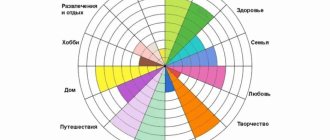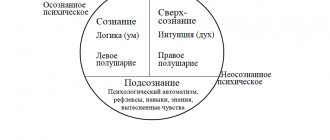Drawing up a psychological portrait - why is it necessary?
A psychological portrait of a child helps educators and teachers find an individual approach to each student.
Identifying the characteristic features of each child will allow you to competently build the process of development and upbringing. A psychological portrait of a person is often drawn up when applying for a job. With its help, managers will be better able to organize the activities of personnel in the company, increase the efficiency and success of each team member.
Psychological portraits of criminals differ from the characteristics of law-abiding citizens, since they are characterized by emotional and volitional deformations, criminal motives and negative social interests. The problem of the identity of fraudsters and murderers is central to criminology and other sciences that are related to crime. Psychological portraits of criminals help the investigator understand the motives for the unlawful act committed.
There are as many individuals as there are people, because each person is an individual. Let us briefly consider the main components that make up the psychological portrait of a person.
When writing a description, the following aspects must be taken into account:
- A person’s belonging to one of four types of temperament;
- Level of intelligence, attitude towards intellectual pursuits, presence or absence of an inclination towards mental work;
- Features and character traits;
- The individual's level of self-esteem.
It is also necessary to take into account the personality’s orientation inward (to oneself) or to the external environment, since all people are divided into two types: extroverts and introverts.
Temperament
The doctrine of temperament comes from Ancient Greece. According to ancient doctors, people can be divided into four groups: choleric, sanguine, phlegmatic and melancholic. This division is rather symbolic. Pure types of temperament are rarely found in people; most often one type is leading, but at the same time a person is characterized by several striking features of another temperament. Examples are a choleric person with sanguine traits, a phlegmatic person with melancholic traits.
A portrait largely depends on temperament
Intelligence
The psychological portrait certainly includes the level of intelligence and predisposition to a certain type of intellectual activity. The intellectual level can be high, average or below average. Special tests, as well as a personal conversation with the client, will help determine it.
Character
One of the most difficult stages of drawing up a portrait is identifying the leading character traits, since a person can successfully disguise them, hiding negative traits and flaunting positive ones. Therefore, at this stage, a conversation with relatives and close friends of the individual can help the psychologist; they will be able to objectively describe his character.
Attention! People who do not understand psychology often confuse character with temperament. Temperament is a set of innate mental properties, and character is an acquired habit of acting in a certain way. A person is born with one temperament or another, and character is formed as a result of upbringing. Therefore, for example, two phlegmatic people may have different characters: one person is stubborn, the other is easily influenced by others.
Ability to communicate
The ability to communicate constructively and the desire to do so are not inherent in everyone. In addition, a person communicates differently with close and unfamiliar people, with friends and relatives. The psychologist’s task is to describe the client’s basic manner of communication and draw a conclusion about whether he communicates correctly with others.
Emotionality
The level of development of emotions is an integral part of the psychological portrait of any person. In professional terms, it is necessary to assess the level of empathy - the ability to sympathize and worry about other people. All people have different abilities for empathy.
Capabilities
Do not confuse such concepts of practical psychology as abilities and talents. If talent is a natural gift, then ability is just a person’s natural predisposition to any activity, physical or intellectual work (sports, music, monotonous monotonous work).
All people have different abilities and talents
Self-esteem
Self-esteem plays an important role in creating a person's image. If it is underestimated, the client should develop self-confidence. If it is too high, the task of the psychologist is to teach the person to look at things adequately and realistically.
Focus
Each personality has its own vector of social orientation: inward or outward. In the first case we can talk about introverts, in the second – about extroverts. Introverts often have a higher level of intelligence, but extroverts have better developed social and adaptive skills.
What is this in psychology
The inner world of people includes character traits, acquired knowledge and skills. In psychology, human personality traits mean positive characteristics and properties.
Each person is an individual, distinguished by character traits, interests and needs, and the ability to set life priorities. This influences social relations and helps (or prevents) people from achieving specific goals.
To become a personality, a person goes through a difficult path of formation. The qualities of people are influenced by regulatory mechanisms:
- external – needs, interests, directions;
- internal – self-esteem, consciousness, respect, etc.
Note! Psychological qualities (character, temperament, state of mind) are important in a person. They guide the individual, make him capable (or incapable) of interacting with others, of performing a certain type of activity.
Personal qualities
Everyone comes into this world with zero knowledge and abilities, but with the makings of a temperament determined by the state of the nervous system and physiological characteristics. The further formation of a person’s personal qualities is influenced by the following aspects:
- the conditions in which the child grows up;
- educational measures taken towards him;
- relationships outside the family;
- even illnesses suffered in childhood.
Under the influence of these factors, some become phlegmatic and melancholic, while others become choleric and sanguine. Someone strives for communication, making plans for life and achieving goals. Others isolate themselves from the world and become fixated on satisfying personal needs.
Sample of a finished portrait, writing rules
When drawing up a psychoportrait, you should be as objective and accurate as possible, and also use a variety of methods of working with the client. You should not add your own assessment of the person to the description. Here is an example of a finished portrait that you can compose. The technique for painting portraits of men and women is approximately the same.
Client ... years old (last name, first name) has the following psychological characteristics:
- Choleric temperament;
- IQ level is above average;
- Tenacious, persistent character;
- Developed ability to communicate and persuade;
- Low level of empathy;
- Ability to speak and lead in a team;
- Heightened self-esteem;
- Typical extrovert.
This option can be used as a sample, for example, during consultations with a client. Based on the results of the portrait, recommendations are drawn up.
In order to correctly describe a person, you must, first of all, have a desire to understand people and sincere sympathy for them. In this case, the person will open up as much as possible during the conversation, and the psychologist will easily describe his characteristic features. The main thing is objectivity during compilation and the ability to look at a person’s personality from the outside with a fresh, not “washed out” look. Then the finished portrait will turn out bright, interesting and reliable.
Behavioral portrait
Behavioral portrait - what does it mean?
This is a psychological characteristic of human behavior that he demonstrates in different life situations.
Such information can be obtained as a result of observing the object, as well as through a conversation with the person himself and his close people.
The behavioral portrait includes the following information:
- appearance;
- pantomime;
- facial expressions;
- speech;
- attitude towards others;
- attitude towards oneself;
- behavior during main activities;
- reaction to conflicts.
Psychological characteristics of a 7th grade student
The boy is friendly, emotional, very impulsive, restless, sometimes it seems that the child does not control his actions and statements. Subject to frequent mood swings. Social distance is not always maintained.
With a little help from an adult, he can independently identify a learning task, build a hypothesis, predict the result, choose a method of action, act in accordance with the chosen or learned instructions, and shows a tendency to non-standard ways of solving learning problems. Does not always give an adequate assessment of his own activities.
The boy has a wide range of cognitive interests and high learning potential. However, educational activities are not a priority.
Features of the development of sensory systems:
- the leading perception system is auditory;
- concentration of attention corresponds to the average level;
- stability and distribution of attention according to several criteria is at a medium-low level;
- the volume of visual and auditory-verbal memory is at the upper normative limit of the age norm.
The speech sphere is without features.
The type of nervous system is moderately weak: during monotonous activity, fatigue in the form of satiety is observed, but is capable of short-term mobilization. Little time is required for processing; the greatest productivity corresponds to the first half and middle of the lesson. The pace of mental activity corresponds to the age norm.
The emotional-personal sphere is characterized by increased anxiety and the desire for self-affirmation and leadership in the group (self-esteem is low with an adequately high level of aspirations). He has difficulty comparing himself to others, so he prefers individual communication with teachers, especially in situations where knowledge is being tested.
The façade of lack of educational motivation hides a high level of anxiety, which at times can even manifest itself in refusal to do activities in case of expectation of “failure.” The peculiarities of his upbringing have led to the fact that the boy, copying the behavior of his older brother and often provoking adults to a negative assessment of his actions, involuntarily seeks to confirm it. In a group of peers he occupies the position of an informal leader.
When organizing the educational process, a child sometimes needs organizing and stimulating help at the stage of comprehending the task. When learning new or difficult educational material, it is better to offer it in the first half of the lesson. If difficulties arise while completing a task, you should repeat the complex material again. If signs of fatigue appear, you should change the type of activity.
To overcome anxiety, it is advisable for the child to offer those types of tasks (providing the opportunity to consult with the teacher) that involve the use of non-standard solution methods and in which the boy can be most successful. When assessing activities, it is better to express critical comments confidentially and be sure to provide reasons.
It should be borne in mind that the external behavioral manifestations of a child often do not correspond to his internal state of mind.
The boy has been studying at school since the beginning of the current school year; the adaptation process has not yet been completed. In general, the teenager is friendly, calm, and experiences some difficulties in establishing contacts. Maintains social distance.
Left-handed (it is recommended to tell teachers in detail about the peculiarities of educational activities and the emotional sphere of left-handed people).
With a little help from an adult, he can independently identify a learning task, build a hypothesis, predict the result, choose a method of action, work in accordance with selected or learned instructions, and shows a penchant for creative ways to solve learning problems. Can give an adequate assessment of one's own activities.
Free legal consultation
We will answer your question in 5 minutes!
Free legal consultation
We will answer your question in 5 minutes!
Has a wide range of educational interests.
- the leading perception system is auditory;
- concentration of attention corresponds to a high level;
- stability and distribution of attention according to several criteria is at a high level;
- The volume of visual and auditory-verbal memory corresponds to the age norm.
A feature of the speech sphere is impaired sound pronunciation. This can cause private dysgraphic errors and, in turn, require the student to consult a speech therapist and additional classes in the Russian language.
The type of nervous system is moderately weak: during monotonous, monotonous activities, the child, experiencing fatigue and satiety, strives to rationally distribute his forces and is capable of short-term mobilization. It takes a little time to master the task, after which a rather long productive period of activity begins, which coincides with approximately the first half of the lesson. The pace of mental activity corresponds to the upper normative limits.
The emotional and personal sphere is characterized by high anxiety caused by dissatisfaction with one’s physical characteristics. This anxiety situationally manifests itself in verbal aggression of a defensive nature. The teenager has adequate self-esteem with a high level of aspirations. Accepted in the peer group.
Sanguine
Motto: trust, but verify!
The advantages of this type of temperament are cheerfulness, sociability, enthusiasm and responsiveness, and the disadvantages are scatteredness, over-sociability, frivolity, a tendency to arrogance, superficiality and unreliability. The psychological portrait of a person marked “sanguine” is as follows: the individual is always happy to promise something so as not to offend the applicant, but he does not always keep his word, so you should check whether he fulfilled his promise.
Sanguines and cholerics
Each type of temperament has its own characteristics, so each personality requires an individual approach. Sanguine people have a strong nervous system and easily experience changes in mental processes: their excitement quickly gives way to inhibition and vice versa. Because of this, they tend not to always fulfill their promises and need control.
But their positive traits usually outweigh the negative ones. Such individuals are endowed with sociability, sociability and optimism. In most cases, sanguine people are leaders and often occupy leadership positions in social life.
Cholerics are known for their unbalanced nervous system. The process of excitation in them prevails over inhibition. Cholerics feel the need to be busy all the time. They, like sanguine people, strive for leadership, but are often too assertive and hot-tempered.
Psychological presentation of an 8th grade student
The girl is calm, reasonable, easily establishes contacts, and is interested in the results of her activities. Maintains social distance. Focused on formal compliance with social norms.
Can independently navigate a learning task, build a hypothesis, predict a result, choose a method of action, work in accordance with well-learned instructions, evaluate the results of one’s activities (there is a tendency to overestimate). For a girl, the formal side of assessing her success is more important.
Cognitive interests are formed and cover subjects of the humanities and natural sciences.
- the leading system of perception is auditory, lower - visual;
- concentration of attention at an average level;
- stability and distribution of attention according to a number of characteristics - at an average level;
- The volume of visual and auditory-verbal memory corresponds to the age norm.
The speech sphere is without features.
Type of nervous system - medium: potentially capable of withstanding long-term stress during monotonous activity. It takes considerable time to get into the task, after which the most productive period of activity begins, corresponding to the middle and second half of the lesson. The pace of mental activity is high. Fatigue occurs in the form of satiety.
The emotional sphere is characterized by high situational anxiety due to the desire to meet the “ideal” created by the girl under the influence of the inflated demands of significant adults (parents), and the fear of not meeting expectations.
The external impression of inadequately high self-esteem hides internal dissatisfaction with her real achievements, which is why the girl attaches so much importance to formal signs of success (good grades). The level of claims is too high. Accepted in the peer group.
Choleric
Motto: not a moment of peace!
The principle of communicating with a choleric person is based on the use of his advantages: enthusiasm, mobility, energy, passion and determination. At the same time, it neutralizes the disadvantages of this type of temperament: aggressiveness, intolerance, lack of self-control, and conflict. A psychological portrait with the characteristic “choleric” should suggest that a person should always be busy with some kind of activity. Otherwise, he will direct all his energy and activity to the team and can disintegrate it from the inside.
Key elements
The psychological portrait includes a description of the following personality traits:
- Temperament . It is customary to divide people into sanguine, choleric, melancholic and phlegmatic. Usually, temperaments are rare in their pure form; more often, two similar types are combined in a person. Choleric people are active and purposeful, melancholic people are sensitive and vulnerable, sanguine people are extremely friendly and sociable, and phlegmatic people are reliable and calm. Depending on the rhythm of mental processes, people participate in activities, behave in relationships and enter into communication differently. Temperament is an innate, not an acquired quality. That is, a phlegmatic person will never become a choleric person, regardless of the degree of influence of external circumstances. Only some adjustment of the initial data is possible.
- Character .
This personality trait is also manifested in the presence of stable behavioral traits. But character is formed to a greater extent as one grows up under the influence of life circumstances and upbringing. And although its basis is made up of traits inherited from previous generations, they are largely supplemented by acquired moral and moral attitudes.
Melancholic
Motto: do no harm!
The psychological portrait marked “melancholic” is as follows: the strengths of the personality are gentleness, the ability to sympathize, humanity, high sensitivity and goodwill. The disadvantages of this type of temperament are suspiciousness, shyness, low performance, isolation, daydreaming and vulnerability.
It is very difficult to find an individual who would fully meet a certain temperament; usually one of them is dominant.
Intelligence
Intelligence is a system of mental processes that ensures the implementation of an individual’s ability to assess the current situation, make decisions and regulate their behavior in accordance with this. As a rule, intelligence is important if the situation is non-standard - as a symbol of the individual’s learning everything new.
Jean Piaget, a psychologist from France, called interaction with the outside world through adaptation to it one of the most important functions of the intellect. Or, in other words, the ability to navigate conditions and rationally structure one’s behavior.
The core of intelligence is a person’s ability to identify basic properties in a situation and structure his behavior in accordance with them. The Soviet psychologist S. L. Rubinstein in his works considered this category as a type of personal behavior - “smart behavior”.
Psychological characteristics of a 7th grade student
Character is a set of individual characteristics of a person that develop and manifest themselves in communication and activity. A psychological portrait of a person is an example of how identified character traits help determine typical behavior patterns.
Character traits are stable properties and qualities of human behavior that have become properties of the personality itself. A psychological portrait is an example of displaying the most typical and significant features of human character.
Its structure includes 4 groups of traits that express the individual’s attitude to various aspects of activity: to himself, to work, to society and the team, as well as to things.
There are three most important psychological characteristics of a person:
- sustainability,
- unity,
- activity.
Despite the variability and plasticity of a person’s mental manifestations, the relative constancy of his mental makeup is clearly manifested, which makes it possible to predict the behavior of a certain person in different situations.
The activity of the individual is expressed in multilateral and diverse activities, which are aimed at understanding and transforming the world around us, at transforming our own nature and mental make-up.
For empirical psychological characterization of personality, it is necessary to determine the direction of analysis. This is due to the complexity and inconsistency of the object.
A correct understanding of personality requires an analysis of the social situation in which the personality develops, its social position and status. By studying the dynamic tendencies of an individual, in particular, his needs, interests, motives, desires, value orientations, attitudes, ideals, and his orientation, one can understand and interpret the content of the social roles performed by the individual, his status and position.
It should be noted that the quality of the roles performed, status, position are determined both by the dynamic tendencies of the individual and the potential of individual mental development, inclinations, abilities and talents.
Realized social roles, personal status, motives and needs, value orientations and attitudes, the dynamics and structure of personal relationships are transformed into a system of stable personality traits - character traits that express a person’s attitude towards people, the environment and himself.
The first thing that characterizes a person from the mental side is his interests and inclinations, which express the direction of the personality.
The very fact of directing our consciousness at a given moment to some specific object is called, as we already know, attention. By interests we mean such an attitude towards an object that creates a tendency to primarily pay attention to it. If we characterize a person, then by this we mean that he strives to go to the theater as often as possible, reads books about the theater, does not miss messages, notes and articles concerning the theater in newspapers, that, while participating in a conversation or listening to radio broadcasts, he pays attention to everything that is somehow related to the theater, so that, finally, his thoughts are often directed towards the theater.
There is some difference between the concepts of “interest” and “inclination”. By interest we mean a focus on a specific subject, while by inclination we mean a focus on engaging in a specific activity. Interest is a tendency to get acquainted with some subject, to study it, the desire to perceive it, to think about it. Addiction is a tendency to engage in a particular activity.
The emergence of interests and inclinations is based on needs. However, not every need generates a stable interest that characterizes a person’s orientation. The need for food is one of the basic needs of every person. When this need is not sufficiently satisfied, i.e.
When characterizing a person’s orientation, we first of all pay attention to the content and breadth of his interests.
If a person’s orientation is limited to just one isolated interest, which has no support either in a worldview or in a genuine love for life in all the richness of its manifestations, then no matter how significant the subject of this interest is in itself, neither normal development nor a full-fledged life of the individual is possible .
Full development of personality presupposes a greater breadth of interests, without which a rich content of mental life is impossible. The amazing abundance of knowledge that distinguishes many outstanding people is based on such a breadth of interests.
Equally important is the sustainability of interests. There are people who are interested in a wide variety of subjects, but not for long; one interest is quickly replaced by another. For some people these fleeting interests are very strong and emotionally exciting; Such people are usually called “addicted” people.
Abilities are those mental properties that are conditions for the successful performance of one or more activities.
Free legal consultation
We will answer your question in 5 minutes!
Free legal consultation
We will answer your question in 5 minutes!
Ask a Question
We call ability, for example, observation, which is of great importance in the activities of a writer, scientist, and teacher. We call visual memory abilities, which are directly related to the work of an artist-painter; emotional memory and emotional imagination, which play a big role in the writer’s work;
The totality of those inclinations that constitute the natural prerequisite for the development of abilities is called giftedness.
The most important among the inclinations are those characteristics that underlie the differences in the types of higher nervous activity: strength, balance and mobility of the processes of excitation and inhibition. Therefore, a person’s talent is closely related to his innate type of higher nervous activity.
The success of a person in performing any activity depends not only on his abilities. First of all and most of all, it depends on his having the appropriate knowledge, skills, abilities, i.e. depends on what systems of temporary connections he has developed. Hence the importance of training for a person’s suitability for doing a particular activity is clear.
But the abilities themselves, as stated above, although they depend on natural inclinations, are always the result of development. The development of abilities is carried out in the process of the very activity for which these abilities are necessary, and above all in the process of teaching this activity. In the learning process, firstly, new systems of temporary connections are developed, i.e.
One of the characteristic signs of good inclinations to develop some ability is early and, moreover, independent, i.e. manifestation of this ability that does not require special pedagogical measures. It is known that some children, long before the start of systematic training in drawing or music, attract attention with their abilities in these subjects.
Temperament
Since ancient times, it has been customary to distinguish four main temperaments: choleric, sanguine, melancholic and phlegmatic.
Temperament refers to the individual characteristics of a person, expressed by:
- in emotional excitability (the speed at which feelings arise and their strength),
- in a greater or lesser tendency to strongly express feelings externally (in movements, speech, facial expressions, etc.),
- in the speed of movements, general mobility of a person.
Typical representatives of each temperament can be characterized as follows.
Choleric is a fast, sometimes impetuous person, with strong, quickly igniting feelings, clearly reflected in speech, facial expressions, and gestures; often hot-tempered, prone to violent emotional outbursts.
A sanguine person is a fast, agile person who gives an emotional response to all impressions; his feelings are directly reflected in external behavior, but they are not strong and are easily replaced.
A melancholic person is a person distinguished by a relatively small variety of emotional experiences, but by their great strength and duration; he doesn’t respond to everything, but when he does, he experiences it strongly, although he expresses little of his feelings outwardly.
- Characteristic features of a person of this type:
- activity;
- quick response to changes;
- easy experience of failures.
Platonov's method in society
Palatonov’s method is used in various creative shows, politics, and science. Indeed, in this activity, the psychological portrait is primarily important. It is impossible for a famous person, just like an ordinary person, to avoid such a characteristic. In this case, the scientist Platonov proposes to consider a person’s intelligence and orientation.
That is, does he have a certain talent and will he be able to realize it based on willpower? In addition, experts take into account a person’s ability to manage their emotions in a state of passion and control moods and feelings.
Ability to communicate
Communication is an extremely delicate and subtle process of interaction between people. It is in it that the individual characteristics of each participant in the process are most comprehensively revealed, therefore this characteristic is extremely important for such an interpretation of the personality as a psychological portrait.
An example of the most obvious function of communication is the transfer of information: any information, content and meaning. This side of communication is called semantic, or semantic. Transmission has an impact on a person’s behavior, his actions and actions, as well as on the organization and state of his inner world.
In general, there are informational, control, and cognitive functions of communication; in addition, there is a function of exchanging mental states and emotions.
What is it for?
Everyone can try to make their own psycho-portrait or study the behavior of a loved one. However, to obtain accurate and most reliable data, it is better to seek help from a specialist. To fully determine your personality characteristics, sign up for my personal consultation. Having such data, you can find the most suitable occupation, hobby, find out the degree of your openness and sociability, identify goals, and increase self-esteem.
Emotionality
Since the time of the ancient Greek thinker Plato, the entire mental life of an individual has been divided into three relatively independent units: mind, will and emotions.
If the will and mind are subordinated to a person at least to some extent, then emotions always arise regardless of our desire. This is a reflection of personal significance and assessment of situations for the process of human life in the form of feelings and experiences. This is where the subjectivity and involuntariness of emotions are manifested. The ability to manage emotions is necessary primarily for health and ambition.
What does it mean to be able to manage emotions? Most often, this statement means hiding them. It hurts, but we won’t show it, we’re ashamed, but we pretend to be indifferent, it’s offensive, but outwardly we’ll only show irritation and anger. But because a person does not show his emotions, they do not become weaker, rather, on the contrary, or take the form of defense - aggression.
Compilation example
A psychological portrait, regardless of its purpose, is drawn up by a specialist. The psychologist determines the appropriate methodology in accordance with the purpose of the test. For independent analysis, you can use simplified methods. Socionics and DISC research are suitable, for example. Such tests can be taken online - they are available on the Internet.
What does a finished psychological portrait look like? An example is presented below. His conclusion is based on the results of tests by Eysenck, Mehrabian, and Cattell:
- Elena Nikiforova, student, 20 years old;
- character traits: sociability, friendliness, impulsiveness, good nature, tendency to aggression, actions under the influence of emotions, emotionality;
- temperament (Eysenck test): sanguine, easy to communicate, make friends, good ability to adapt;
- intellectual qualities (Cattell test): quick perception of information, abstract thinking;
- motivation (Mehrabian test): achieving the intended goal;
- emotionality: average stability, irritability, excitability, stubbornness;
- sociable qualities: sociability, independence, activity, desire for leadership, good adaptive abilities;
- conclusions: the results of the study are within normal limits, it is recommended to pay attention to increased suspicion.
After a detailed consideration of what a psychological portrait is, its role in the modern world becomes clear. It is used in many areas of human life: in the professional, social, and personal spheres. The psychological characteristics of an individual are an important factor in choosing a life path and career path.
IMPORTANT! Informational article! Before use, you should consult a specialist.
Capabilities
A psychological portrait of a personality is an example of a description of a person’s internal make-up, which includes such characteristics as abilities.
In psychology, abilities are considered as a special property of a psychological system, which is expressed in a certain level of its productivity. Accuracy, stability and speed of functioning are quantitative parameters of the productivity of abilities. They are measured by solving problems of a certain degree of complexity, resolving conflicts, etc.
The degree of resolvability of contradictions between personality relationships and the characteristics of an individual is the level of abilities. The most successful option is when there is an inclination towards a certain field of activity coupled with an interest in this matter.
Abilities are divided into special and general. General ones can predetermine a tendency towards a fairly wide range of activities. They are formed by the development of intelligence and personality traits. Special acts as a socio-psychological basis for the development of craving for a certain field of activity: research, music, teaching, creative, etc.
Classification of personality traits
The characteristics of people are assessed according to 2 parameters: internal and external. To consider the first ones, you need to talk with the person for some time. The second qualities are nothing more than a “signboard”; they do not always convey true information.
Inner world
Volitional personality traits - what is it in psychology, their formation.
It can be rich in content or primitive. In the first case, people will be drawn to the person, assessing his personal qualities. In the second option, there is unlikely to be a desire to develop relationships. To become in demand in any environment, an individual must:
- look at the world positively;
- be able to think freely;
- do not depend on other people’s opinions (be yourself);
- take care of others;
- easy to make contact;
- realistically assess the situation.
Note! A person needs to develop his inner world, constantly absorbing new knowledge and applying it in practice. It is more interesting to communicate with a versatile, friendly personality.
External surroundings
People are greeted not only by their clothes, but also by their ability to present themselves. A beautiful sign is formed from the created image and behavior of a person. They work on the surroundings:
- attractive appearance;
- ability to choose a clothing style;
Image works for success
- beautiful body language;
- artistry;
- ability to conduct dialogue.
You can have a beautiful sign and at the same time have negative internal properties. Such disharmony cannot lead to real success.
Focus
Motivation for activity and behavior, satisfaction of needs - all this underlies the orientation of the individual (on a task, on oneself or on communication).
Some may only be satisfied with security and satisfaction of physiological needs. And for others, in addition to this, it is no less important to satisfy social needs, the need for self-expression, and also to realize their creative abilities. The main task of a manager and psychologist is to identify the needs, beliefs and interests of each individual and determine the direction of his motives.










